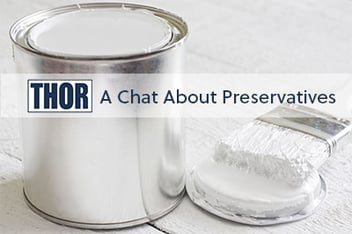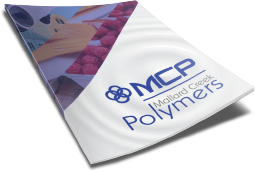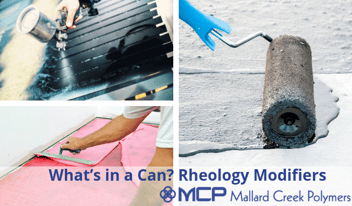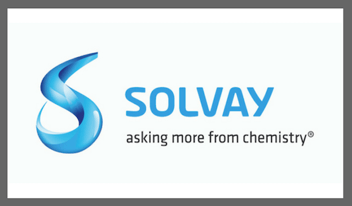
What's in Your Can? A Chat With Evonik About Defoamers & Deaerators
Mallard Creek Polymers: What is a defoamer / deaerator’s purpose in the system?
Evonik: Defoamers prevent formation of foam during manufacture and application of coatings and printing inks. Foam that is already formed is destroyed and air occlusions are prevented. Deaerators prevent development of air occlusions and pinholes.
 MCP: Why use a defoamer?
MCP: Why use a defoamer?
Evonik: The occurrence of foam is considered an undesirable but unavoidable phenomenon in coatings and printing inks. The formation of foam interrupts production processes, reduces the effective volumes in the production plant, and leads to unnecessary down time. Foam also interferes with the application process. In printing, foam can cause the ink reservoirs to overflow and can impair ink transfer from the printing cylinder to the substrate. Dried foam leaves surface defects in the paint film. To prevent foam and destroy any foam present, defoamers must be added to the formulation.
MCP: defoamer vs. deaerator?
Evonik: To eliminate macro-foam on the surface, to prevent air occlusions, and to ensure rapid foam collapse in waterborne formulations, defoamers are preferred. If finely dispersed air needs to be removed from the system, deaerators are preferred. Most defoamers are also effective (to some extent) as deaerators, and the reverse is also true.
Defoamers work by penetrating the foam lamella, destabilizing it, and making it burst.
MCP: What classes of substances have a defoaming effect in waterborne coatings?
Evonik: Typical active substances for formulating defoamers for waterborne coatings are polysiloxanes (silicones), mineral / vegetable oils, and/or polymers. Polysiloxanes belong to the most widely used group of defoaming substances. They are used frequently in modern waterborne coatings and printing inks where high demands are made on defoaming characteristics and surface finishes. What substances are effective deaerators? Typical substances for formulating deaerators are organic polymers (polyethers, polyacrylates), dimethyl polysiloxanes (silicone oils), organically modified polysiloxanes, and fluorosilicones.
MCP: What to consider when selecting a defoamer / deaerator:
Evonik: Defoamer compatibility: A defoamer must be insoluble in the formulation to be defoamed, where it should be present in the form of finely divided droplets. Furthermore, it is necessary for it to be compatible with the medium to be defoamed as not to cause surface defects (craters). The choice of defoamer is always a compromise between defoaming performance and compatibility / insolubility.
Micro vs. macro-foam: Macro-foam is the foam visible on the surface. Micro-foam consists of very fine foam bubbles that are entrapped in the matrix of the coating film. Use a deaerator for micro-foam. Use a defoamer for macro-foam.
In-process, in can (grind, letdown, post addition) vs. application (brush, spray): Depends on the defoamer supply form / whether defoamer droplets are pre-formed. Defoamer emulsions (defoamer droplets are already finely distributed) may be incorporated in the formulation using low stirring intensity. They may also be suitable for subsequent addition in the ready-to-use formulation. Defoamer concentrates (defoamer droplets must be generated by formulator) must be incorporated by finely dispersing the defoamer in the coating using high-shear forces. It is recommended that the defoamer be added to the mill-base. Deaerators can be added to the mill-base or the letdown; this depends primarily on the incompatibility of the deaerator with the coating system. Application method (curtain coating, airless/airmix) plays a very important role when choosing a deaerator, this depends on compatibility, micro-foam formation, etc.
Viscosity of coating: If the viscosity of the coating is high, the velocity of the rise of the foam bubble is small. This means that air bubbles, particularly in formulations with high viscosity, rise slowly to the coatings surface. The viscosity of the coating increases as drying / curing progresses. Consequently, the bubbles remain in the coating film and result in micro-foam.
VOC, APEO, others: Consider using VOC-compliant and APEO-free defoamers and/or deaerators.
MCP: Do I have the right defoamer? How to know…
Evonik: When choosing a defoamer for a formulation, its effectiveness should be checked in the lab. It is recommended that the test methods permit evaluation under conditions / application methods close to those in practice. The method should also include an assessment of possible surface defects that could be caused by the defoamer.
- Film defects: Craters, turbidity, gloss reduction, and pinholes may all result from improper defoamer selection or usage levels.
- Lab testing: Stir tests – air is stirred into the formulation with a fast-running stirrer. The effectiveness of different defoamers can be compared via the volume of foamed material. Flow tests – air is stirred into the formulation with a fast-running stirrer. The freshly foamed sample is poured onto a surface, where the activity of the defoamer can be assessed from the fresh pour-down. After drying, the film can be visually assessed for foam and surface defects. Roller test – paint is applied with a roller to a substrate and foaming during application is assessed. Surface defects, incompatibilities, and air occlusions in the coating can be assessed on the dried film.
TEGO is a leading brand in the international coating additives industry. Our extensive portfolio includes various additives (such as defoamers, dispersing aids, and hydrophobing agents), co-binders, nanoresins, and heat-resistant silicone resins. TEGO’s diverse product range provides solutions to a wide variety of even the most difficult coatings challenges.
Commercial contact:
Matt Carroll
Phone 1 (804) 727-0666
Cell 1 (804) 201-1613
Technical contact:
Chris Howard
Phone 1 (804) 727-0671
Hotline 1 (888) ASK-TEGO

 Construction
Construction
 Nonwovens
Nonwovens
 Adhesives
Adhesives
 Textiles
Textiles
 Printing & Packaging
Printing & Packaging
 Paper
Paper
 Paints & Coatings
Paints & Coatings





